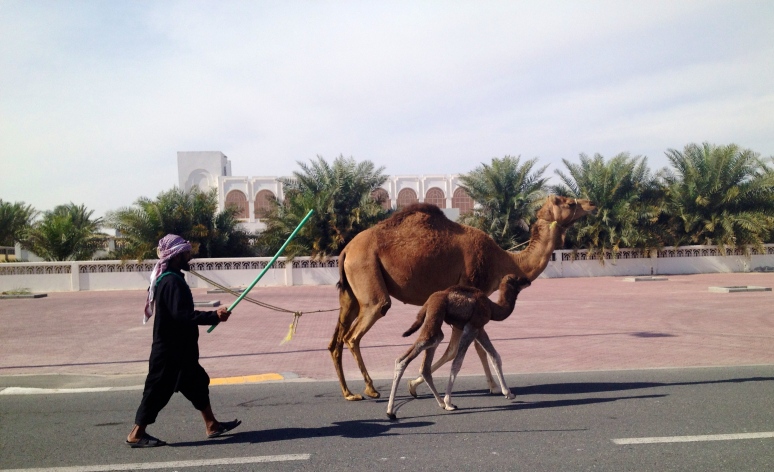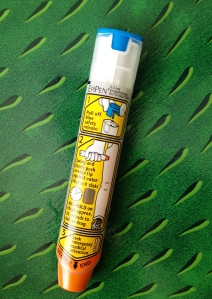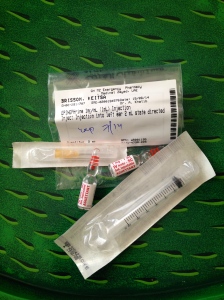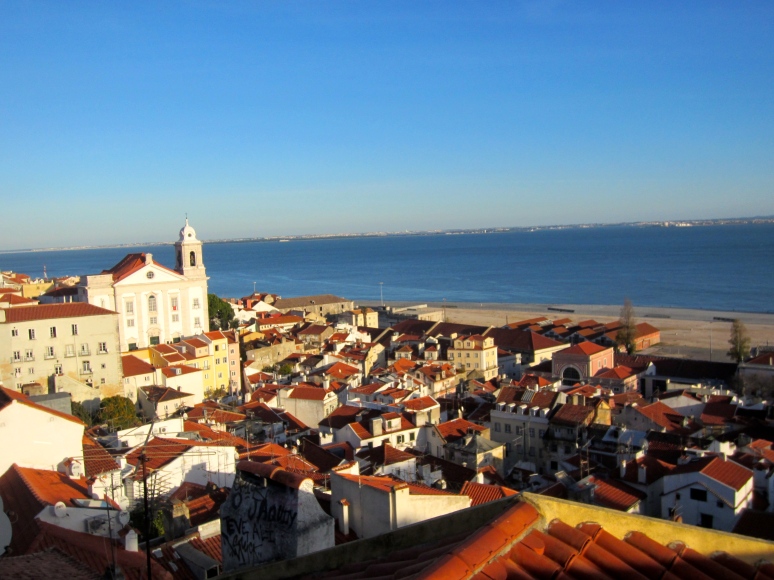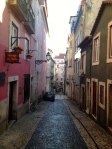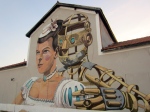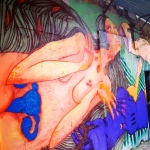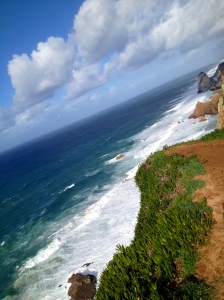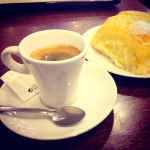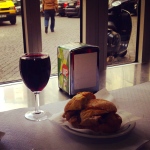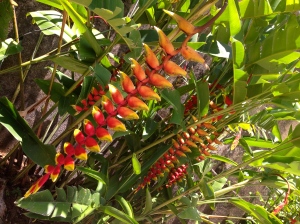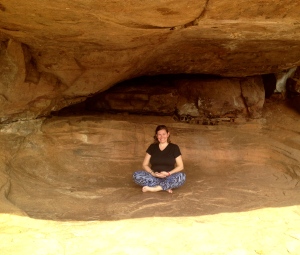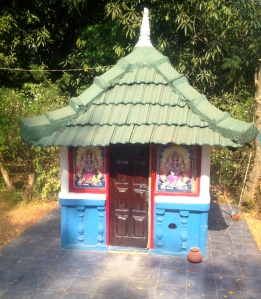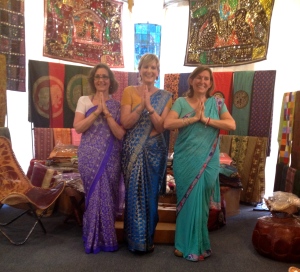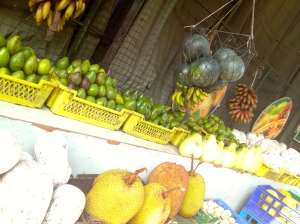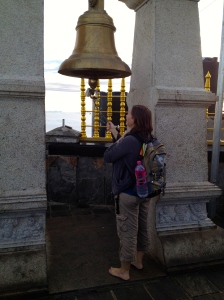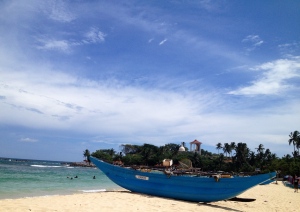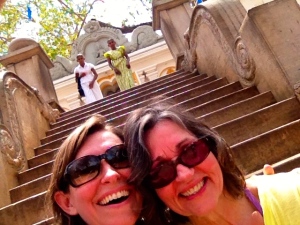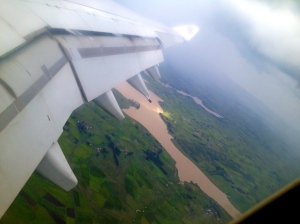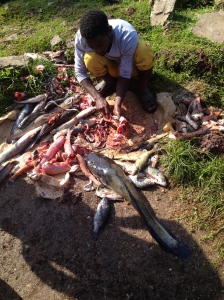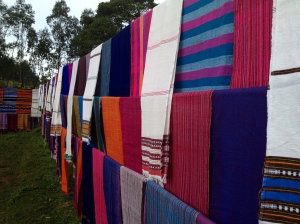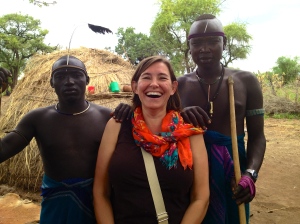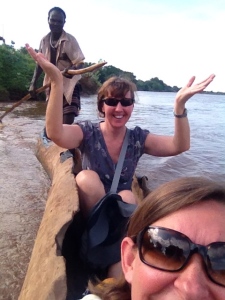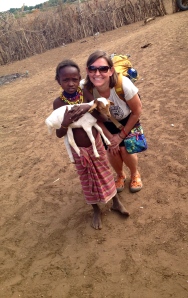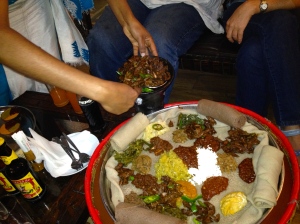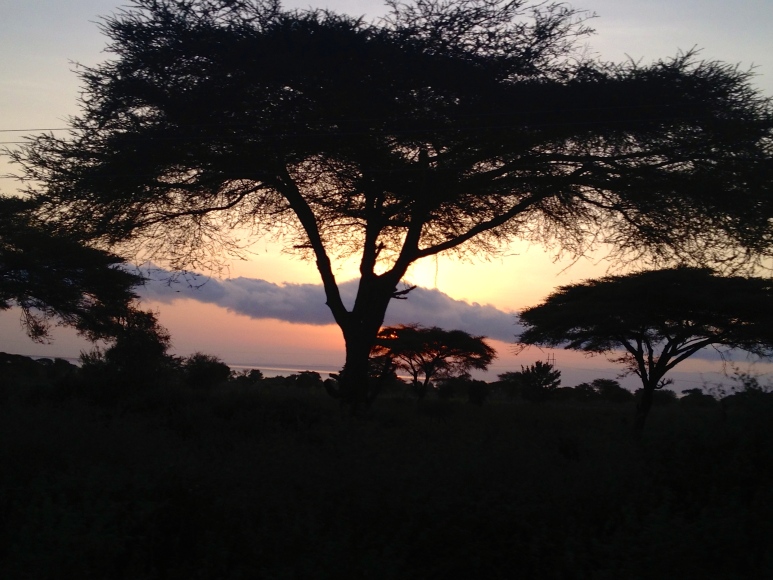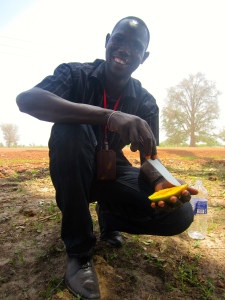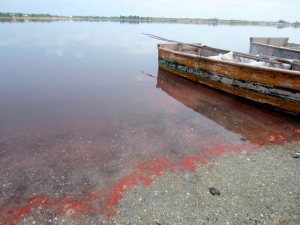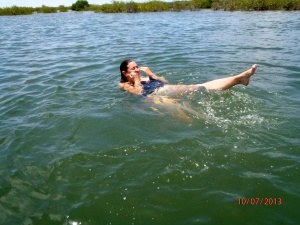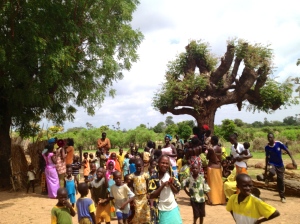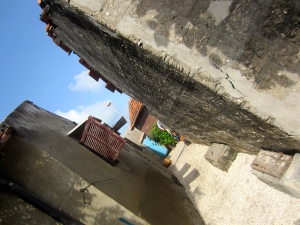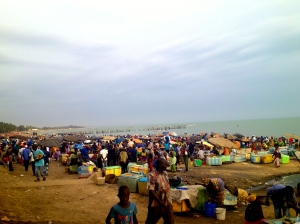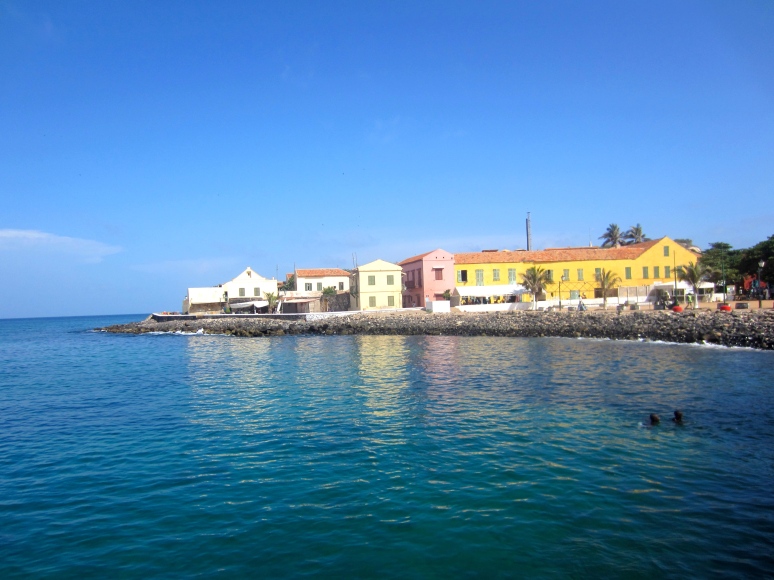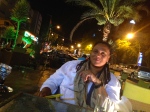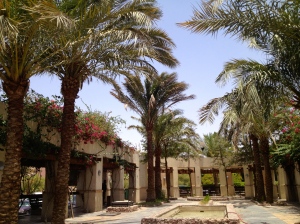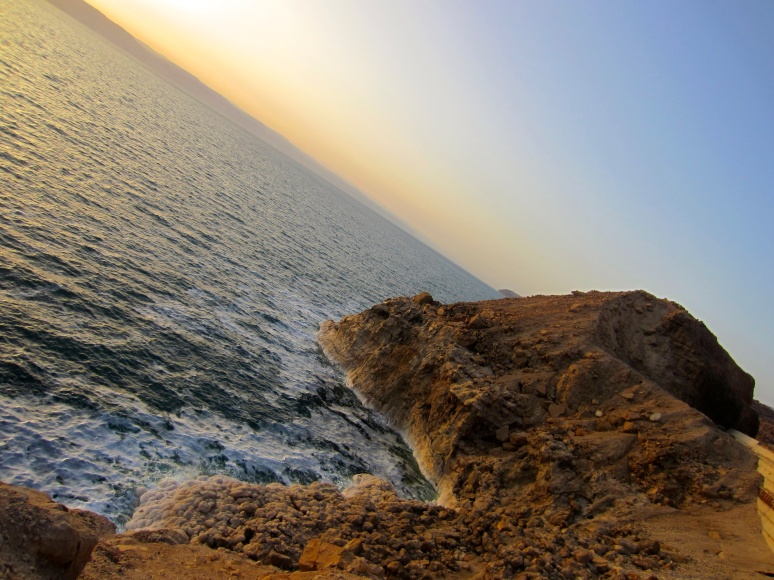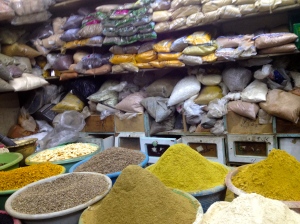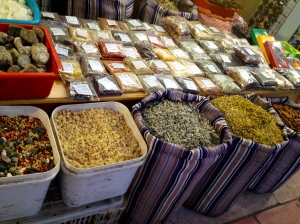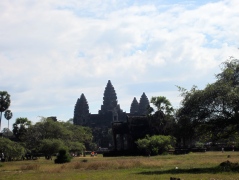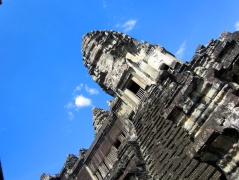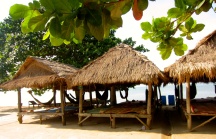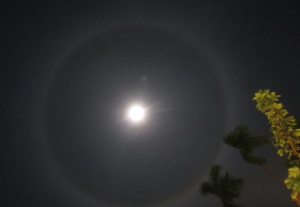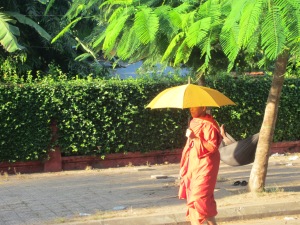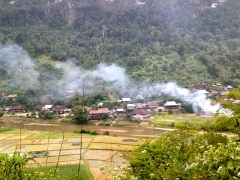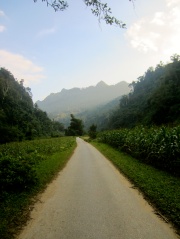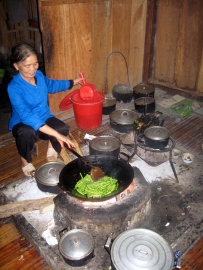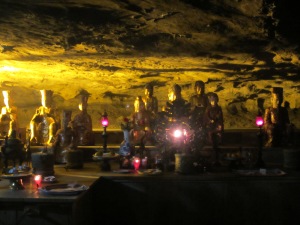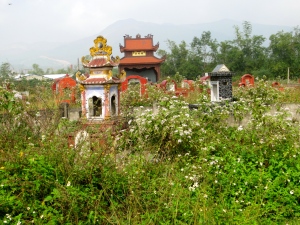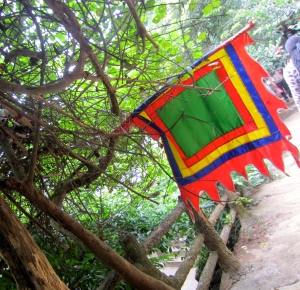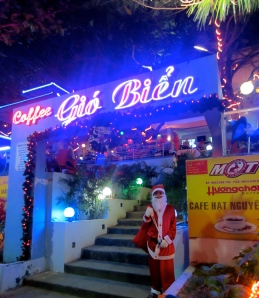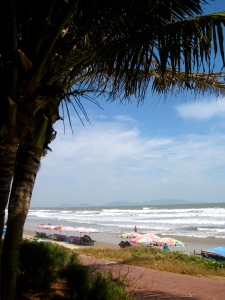globalmidtown
Just another WordPress.com site
just another day in the desert …
In the United States one who does not have health insurance pays heavily for prescriptions & doctor visits. So I like to get whatever I can taken care of in the country in which I live, where I have insurance.
I have incredible allergies that require me to carry an epi-pen with me. My US epi-pen has expired, so I need to get a new one. It’s much less expensive to get this where I live than the US … financially that is.
In my little desert country you can get just about any non-narcotic medication without a prescription. I try several pharmacies – I go in with my old epi-pen (in it’s original box w/ prescription written on side) with no luck. Pharmacy after pharmacy tells me to ‘go to the government hospital’. I happen to be at the dermatologist & ask him about it. He says the same ‘a government hospital is where you will find this’. But, he makes my life a little easier by writing me a prescription.
A week later I head in to the government hospital in my little desert town with my prescription in hand. Positive I have it all under control …
I make my way to the emergency room pharmacy and, after polite conversation, confidently hand my prescription to the pharmacist.
Here it begins …
He first looks at my prescription and says ‘sorry, miss, this prescription is from outside of our hospital. You must check into the hospital and the nurse will take care of this for you.’ That’s not too bad, I think. So I say ‘great, if I check in, the nurse will give me a prescription from your hospital and I can get what need, yes?’ … Not exactly. … the nurse will administer the drug. WHAT?? I don’t need an epi-pen now! I simply need a prescription because mine is expired. The pharmacist then proceeds to explain to me that an epi-pen is not something you take with you … if you need one, you come to the hospital and a nurse will administer.
Ummmm … I attempt to politely explain that I would be dead before I could get to the hospital. Through a lot of miming (including choking motions & lots of ‘dead’ faces) I am able to get the pharmacist to understand that an epi-pen means emergency and one may not have time to get to the nearest hospital. At least, I believe he understands.
He makes several calls to his supervisor. After what seems like ages, he tells me ‘ok, miss, you can get this. Go pay & I will prepare it for you’.
Paying for my prescription is a series of running back and forth to get the correct ‘GH’ number to create a file to pay my 1 AED (less than $0.30).
Finally, I return to the pharmacist with my ‘paid’ receipt. And I wait. And wait. And wait. Eventually, he calls me up with my prescription ready.
I am handed two small sealed glass vials in a little sealed plastic bag.
Ummmm, ‘ excuse me, sir. How am I to administer this?’
‘No, miss, you bring this to the hospital and a nurse will administer’
ARE YOU SERIOUS?!?!?
‘Do you remember the conversation about choking and dying on the side of the road?”
Literally another 15 minute conversation full of miming with bad English and bad Arabic … finally he tells me to go to a triage nurse in emergency & she will take care of me.
I sit and think about this for a minute and decide – I just need to play this right & I can get a needle & be out of there!
So I go to emergency & tell a nurse that I just need a needle to go with my prescription ….. 20 minutes later I leave the hospital with two small sealed glass vials full of epinephrine, two needles, two syringes, and two alcohol pads …. My new epi-pen! I have no idea how I would actually use this ‘epi-pen’, but I have it!
Patience and humor… requirements of desert life.
cafes & castles
This holiday I am doing differently … this holiday I will not leave the desert of Abu Dhabi in a trail of dust as soon as school lets out … this holiday I will give myself time to prepare … time to think … time to spend with myself. I am embarking on this holiday alone … I will go where I please, see what I like, be on my own schedule … I will not feel responsible to or for anyone traveling with me … I will not need to ask the opinion of others or the desires, likes or dislikes of anyone save myself. I am going to Portugal – where I will wander streets, find cozy cafes, people watch, hope to meet locals or fellow travelers, work on a foreign language … and write …
With all of this in mind, I leave the desert in the wee hours of the morning two days after school lets out. I leave after I have had time to say farewell to friends who have already departed for their holidays and to spend time with my cat. I arrive at the airport before dawn in time to meet a chauffeur from my car rental to take my car for service while I am away. On the plane I sit with a Portuguese woman who is visiting home for the holidays – she lives in Abu Dhabi working with the environmental municipality …we talk about life in the desert and how different things there are .. we talk about her work & I learn more than I really want to know about the water quality of this country in which I am living. We take lunch together during our layover in Paris, and continue on to Lisbon. At the airport, we exchange numbers and say our farewells.
I catch a cab to the flat I have rented and it is well after dark when the taxi driver drops me at a corner saying he can’t get into the neighborhood where my flat is. At the bottom of a hill he tells me, through miming, to walk up a while then go right … lugging my bags and completely unsure of where to go, I begin the walk. After wandering a bit on the narrow cobblestone streets, I arrive at a corner that i recognize from the pictures and I hear my name from above. Joana is lovely.. she has lamps lit, windows open, a small space heater on, and candles burning. She gives me maps & suggestions of places I should see in Lisbon, as I have arrived with no information about the area…. I don’t even know the tipping etiquette of the Portuguese! (turns out it’s the average 10%)
I quickly unpack, wash my face, change out of my travel clothes, and head out … after all,. it’s Saturday night in barrio alto – a very busy pub district in Lisbon. Walking the streets, I quickly decide this area is a maze – the streets are extremely narrow (so much so that some are impassible for cars), cobblestone, lined with 3 – 4 story tall buildings. The narrow streets and tall buildings give the effect of a true maze – you can’t see beyond the street that you are on, there is no getting a feeling for where you are by looking into the distance or around the corner – it’s too narrow. After a good meander around, I decide I may end up lost – after all, it is dark and I have no idea of where I am and have neglected to bring one of Joana’s maps with me – so I decide to stop for dinner at a little spot close to my flat.
I go in to the tiny restaurant where two very friendly Portuguese servers greet me. The menu is entirely in Portuguese, so I am at the waiter’s mercy – he brings me grilled pork fillets, bread, cheese, rice, and red wine. I think I am in love.
wandering the streets of Lisbon …
In the morning I wake early and decide I will go to a book talk that Joana told me about. I plug the address of the café into my phone & head out. The café is on the other side of town – the walk takes me through several neighborhoods and shopping centers, it takes me through downtown, and past many squares and monuments, as well as down a beautiful promenade where locals have set up a flea market-type shopping area. After several wrong turns that lead up and down endless stairs and through narrow alleyways, I find the place I am looking for. The café is owned by a biking enthusiast and is an adorable combination of biking supplies, delicious freshly prepared foods, and amazing coffee. Here I meet and chat with several locals, including Joana. The author of the book is an American who is living in Paris. She is a young free-lance writer and I am inspired by her. After a leisurely morning of coffee, delightful Portuguese pastries, and good conversation, I head back towards my Lisbon home. The map app on my phone doesn’t recognize the address of my flat, so I attempt to retrace my steps… needless to say, I end up hopelessly lost on the streets of Lisbon. This is just fine with me …. I slow down and take my time, enjoying the sights of the beautiful Portuguese people, the lovely winding streets, and the incredible and random street art. I spend hours wandering hilly side streets and alleyways, up and down what seems a million sets of stairs … it is simply beautiful. Until I realize my phone is almost out of charge & I am still completely lost! I remember I did bring one of Joana’s maps … I break it out & ask for directions – 30 minutes later I’m safely back in my flat with terribly aching calves.
Street art of Lisbon
It’s December and cool … it’s the low season for Lisbon’s tourist industry, which I don’t think is booming any time of year. Lisbon appears to be a hidden jewel. A good friend of mine says Portugal is her favorite European country – I can see why… the people are beautiful, friendly, and welcoming, without being overbearing; the city of Lisbon is a charming land of the past where the easiest mode of transport is a streetcar. Lisbon is a large city, complete with the big city sounds & smells of cars, emergency vehicles, public transport, pan-handlers, the constant murmur of people chatting … but it is so much more – or, really, so much less. Lisbon looks as if it were cut from the pages of a history book. It is a city of endless meandering streets, charming old buildings in various states of disrepair; it is full of French style architecture and public squares, parks, and monuments. On the outskirts of the city one can spend days wandering the ancient castles and beautiful gardens of Sintra. You can go to the edge of the earth at the western most point in Europe – Cabo da Roca (Cape Roca) where you will be literally blown away by the wind and phenominal view. Time is certainly not of the essence in Lisbon, as people linger over pastries, coffee, and wine. The sound of Portuguese wafting through the air makes for an incredibly romantic atmosphere.
My trip to Portugal is scheduled to include Lisbon, Porto, and the Algarve region. After just a few days in Lisbon, I realize I cannot leave. I have not seen enough of this magical city. I change my reservations and stay the full time in Lisbon, vowing to return to Portugal to see Porto to the north and the Algarve to the south.
Portugal was an amazing treat for me … traveling alone, I spent my days doing some of my favorite things – wandering sweet city streets, talking to people, and finding hidden back alley cafes, and pondering.
birds of paradise
For the springtime break this year, I was fortunate to be able to take a two-week trip to Sri Lanka with my mom and a dear friend from the desert. It was fun to travel in a small group … and it was especially fun to travel with my mom … seeing new places with her was an absolute joy.
Stepping off the plane in Colombo, we were greeted by warm, sunny air, beautiful women dressed in traditional saris, and an unheard of ease of arrival. I felt the immediate benefits of the tropical air kissing my skin and the gentle friendliness of Sri Lanka welcoming me.
Yes, it’s official … I am in love. In love with a place …. again. Sri Lanka has captured my heart. Gentle breezes, warm sunshine, vastly differing landscapes, amazing animal life, beautiful tropical plants everywhere … and the people! The Sri Lankan people are warm and welcoming, stunningly beautiful, and kind beyond words. They walk the streets and sit in shops with huge smiles, greet you sincerely at every turn … the happiness that is exuded from them is incredible… and contagious. Sri Lanka is a gentle land of temples, monkeys, sweet street dogs, tropical plants, humid air, and love for life …. life as it comes and in the moment.
We spent a quick few days in the capital & largest city, Colombo. I am usually not one to love the big cities of a country, as I don’t feel I get as ‘real’ of an experience in the big city. However, Colombo was different. It’s divided into sections (literally numbered quarters), which helps to give it a smaller feel. The city is green with tons of trees, flowers, and lakes. It sits on the ocean and has a beautiful beachfront and port. Tuk-tuks are the major mode of transportation and the roads are good. The traffic is heavy, but not jammed; pedestrians are everywhere – both on foot and bike. It feels as if the entire city is outside. And the city is full of temples … temples, temples, and more temples. Like all of Sri Lanka, as I am soon to discover.
Next we take the train north and east to Anuradhapura. My goal here is to see the Sri Maha Bodhi tree. This tree is believed to have been grown from a branch of the Bodhi tree in India where Buddha sat to achieve enlightenment. Planted in 288 BC, it is the oldest documented tree in the world. It is one of the most sacred relics of Buddhists in Sri Lanka and respected by Buddhists all over the world. Of course, this area of Sri Lanka is riddled with temples, meditation spots, and sacred places. We spend a full day seeing just a few of these old and beautiful spaces.
In the late afternoon we arrive at the Sri Maha Bodhi tree. Monkeys who hang out in giant prides around the gates guard the entrance to the park. Here we were asked to remove our shoes at the entrance; this is not unusual – but what is unusual is the size of this area. It is a small park of sorts, lined with hundreds of Bodhi trees, incense pots, enlightenment candles, stands selling flowers for offerings, prayer flags, beautiful areas to pray, even a small temple. However, the entire park area is made of sand. It is late afternoon and the sun has had all day to work its heat into the white sand. Our feet are almost immediately on fire! This tranquil place of worship is transformed into a scavenger hunt for shaded spots to rest our burning feet. We meet several Monks as we wander the park. They show us the proper way to de-stem our lotus and to light our enlightenment candle. We eventually make our way across the acres of hot, white sand, up the steps, and through the gates to the Sri Maha Bodhi. Here there are several prayer rooms where people leave offerings to show honor. I have bought a few beautiful lotus flowers to leave, after a short blessing; I take my leave of the prayer room and go to see the tree. It is beautiful, but surprisingly small for such an old tree. I find myself thinking, “I would not want to be responsible for caring for this ancient, sacred tree.”
The next morning we’re off to the bus station headed for Kandy. Taking a bus in Sri Lanka is quite the experience. First, it is hot – a no air, no movement, sticky, hot mess. And crowded. And it stops. A LOT. With each stop more people squeeze on. Soon the bus driver is popping down jump seats all over the bus that I didn’t even see. And people are standing on top of me – literally. But they are so friendly and helpful that it’s hard to get irritated. One local offered me a local treat called ‘bwok’ (I am sure I’m not spelling that correctly – but that’s how it sounds) Bwok is some sort of root wrapped in ‘beetle leaves’ with tobacco and lime paste. I skipped the tobacco and lime paste – but I did try the root. It was bitter. And impossible to swallow. I chewed for ages but could not make it go down – finally I gave up and, in what I thought was discrete, put it into a tissue. The man saw and said; “good, now you’re ready for the leaves.” The ‘beetle leaves’ were minty and very green tasting, absolutely delicious after the bitter, dry root. After I had eaten this, I realized that the bus driver and several of the men on the bus were chewing away on the root also. When I asked what it was, I was told it is ‘natural energy’. Maybe I should have asked before I ate it? I sat back and waited, certain I was going to get high or hallucinate. Thankfully, neither happened and all was well. The driver, chewing incessantly on the bwok, sped through windy mountain roads, weaving between tuk-tuks, cattle, and people on foot & bike, all the while texting on his phone. Somehow, I was not the least bit nervous (maybe the bwok did have some effect).
We make it to Kandy late in the evening, found a tuk-tuk & made our way up the mountain to our homestay to meet our host, May. Nestled in the trees, Kandy is a beautiful little city with so much to see and do. Of course, there are temples everywhere; however tea plantations, herbal farms for Ayurvedic remedies and elephant orphanages also surround the town….all of which we took in during our short stay in Kandy. Kandy is a maze of narrow, hilly streets winding though the trees with tuk-tuks at every corner. It was here that I received an Ayurvedic massage and body treatment. This is possibly the most intense three hours my body has ever experienced…. Beginning with a body scrub, moving on to hot oil massage for the scalp, a coffin-type personal steam bath, a shower, and finally an herbal breathing treatment.
After the experience on the bus, and there being no train route where we want to go next, we opt for a driver for the slow trip to Adam’s Peak, the national park, and finally to the beaches in the south. Toga, our driver, picks us up, pills our packs into the trunk, and we are off – headed south. He takes us the long way, stopping at fascinating and scenic areas on the way to Adam’s Peak. Waterfalls, a small town that is referred to as “little England” (it really does look like England – even the misty, relatively chilly weather), tea farms, monkeys, and cool, old guest houses …. All things we would not have seen from the bus – Toga shows us along the way. It is on this route that we stop at a traditional silk shop where we meet several beautiful Hindu women who wrap us in their traditional garment – the sari. I discover this amazing garment is made of one single piece of silk cloth.
When we arrive to the town of Nallathanniya at the base of Adam’s Peak it is late in the evening. Toga jokes that we would have to climb “little Adam’s Peak” to get to our room – at least we thought it was joke – our room is at the very top of the hill – above the hotel… 8 flights of stairs later & we are settled in!
Before embarking on this trip, we all decided we wanted to climb Adam’s Peak. Adam’s Peak is a 7,359-foot tall mountain in central Sri Lanka. It is known for the Sri Pada (‘sacred footprint’) – a rock formation near the summit, which Buddhists believe is the footprint of Buddha, Hindus believe it to be that of Shiva, and in Islamic & Christian traditions it is believed to be the footprint of Adam. The big rock ‘footprint’ at the top makes this beautiful mountain quite the religious pilgrimage for each of these different religions.
The tradition is to hike up the mountain at night to be at the summit for sunrise…. With this in mind, at 1:30 AM we begin our trek across town and up the mountain – climbing steep, wobbly, uneven steps made of rock and stone. Four hours and over 5,000 steps later, on aching, wobbly legs, we near the summit just as light begins to peek through the clouds. We quicken our pace to be at the top when the sun breaks through. The last 50 steps are pure torture fueled by total adrenaline. We stand on the steps at the base of the temple and watch the sun break through the clouds over the tops of surrounding mountains. Breathtaking does not begin to describe the beauty; terms such as ‘spiritual’ or ‘life changing’ cannot describe the feeling of accomplishment and self-love I experience in this moment. The colors I witness bursting through the clouds are of the earth and sun and heavens meeting at this one point and exploding with the light of new dawn. This new dawn has given me a fulfillment and sense of inner peace I have yet to experience. At the beginning of the trail a monk had given me a blessing of safe travels and placed a bracelet on my right wrist. On the summit, I find myself fingering this bracelet with a thoughtful mind. I am thinking of people and choices we each make in life and those who we chose to surround ourselves with… on this trip I am appreciating the goodness of people. The love and care in a stranger’s smile on the street, the helpfulness of the host in Kandy, the accommodating man at the hotel who allowed us to move to a room with a balcony, my friends – old and new – who are there for me when I need a laugh or a shoulder, my family – who is there with love and open arms no matter where I am or how often I come home. I am filled with gratitude for the people in my life.
As usual, the pictures do no justice for this amazing sight and journey.
Next we’re off to Yalla National Park for safari. Here we sleep in a tree house and see elephants, leopards, monitor lizards, peacocks and so much beauty. We visit a beach with a Tsunami memorial for the 49 people who lost their lives on this beach almost 10 years ago. Standing on the beautiful beach, looking out onto the Indian Ocean, I can’t help but remember how much respect we must maintain for the power of nature.
We finish our trip with several days on the southern tip of the island in the small beach town of Unawatuna. Unawatuna is just a few kilometers from the larger town of Galle, which was nearly completely destroyed by the Tsunami. Here almost every local I meet has a Tsunami story. Listening to story after story of the people I meet, I am fascinated by the need we have as humans to share our stories. What is it about words that help us to work through trauma and express joy? The beach is stunningly beautiful and the way of life is laid back and relatively carefree. Drinking coconut juice and eating fresh pineapples by the water’s edge, long walks through the sand, late lunches that watch the sun drop below the horizon, listening to monkeys grunt & howl in the trees and spending endless hours talking with people I love is the way I will remember my time in Unawatuna. Thank you, Sri Lanka, for the lovely experience… for allowing me to love you and be sweetly embraced by your warmth and beauty. Thank you for sharing your tranquility and peace with this desert-dwelling traveler who needed serenity more than I knew.
utopia
Living & working in the uae means we get to celebrate the many Muslim holidays. I enjoy learning what each holiday signifies and how it is traditionally celebrated or recognized. The most recent Muslim holiday was Eid. There are two Eids in the Muslim calendar – the first is Eid al-Fitr, followed by Edi al-Adha. Eid al-Fitr is usually celebrated to mark the end of Ramadan, with Eid Al-Adha being celebrated in the eleventh Islamic month. Literally everything in Islam is based on the moon – the calendar, the holidays & celebrations, the new year, etc. – holidays and celebrations are not on set dates as those of us from the west are accustomed to. It has been a great adjustment for me to understand that I may not know of an upcoming day (or week!) off from work until 3 or 4 days prior when the right person reads the phase of the moon. Often during this time of year one will hear locals saying to each other “Eid Mubarak!” – this is a lovely celebratory greeting that literally translates to “blessed feast”. I love this. Eid al-Adha is a major celebration in the Islamic religion – it is the festival (or feast) of sacrifice. This festival honors Abraham’s (Ibrahim) willingness to sacrifice his first born son, Ishmael (Ismail) as an act of submission to God. Fortunately for Abraham, as the story goes, God intervened and allowed him to sacrifice a lamb rather than his child. In the Islamic calendar, Eid al-Adha falls on the 10th day of Dhu al-Hijjah. This is the 12th and final month of the Islamic calendar – it literally translates to “possessor of the pilgrimage”. This is a sacred time for Muslims in that it is during this month that the Hajj takes place. Hajj is the pilgrimage to Mecca that each Muslim is to take at least once in his or her lifetime.
Knowing this about the moon and the calendar, I knew that we would not know the exact dates we would have off for Eid until just before we were to break. But, I decided to take a chance and book a solid week – fingers crossed I would actually be off work! Several friends and I decided we wanted to go somewhere close by but inexpensive and rich with culture. This criterion led us to Ethiopia. I could not be more thankful or appreciative of an experience.
Before we landed, as I viewed Ethiopia from above, I knew my preconceptions of this land were incorrect. I always pictured Ethiopia as a vast dry land with little greenery and very few trees … much like the “Save the Children” campaign commercials of the late 1980s …. you know the ones “for just a dollar a day you can feed a hungry child”. However, what I viewed from my window seat was quite different – green rolling hills, mountains, and a lot of waterways. We landed in addis ababa on a rainy afternoon to be greeted by our guide Tofari and two drivers. We decided to go with a full tour while on this trip … Ethiopia’s national language is Amharic – which has no roots that I could recognize – and English is spoken very little (if any) outside of addis ababa. We opted for a tour of southern Ethiopia – this is where our research told us we would find adventure and the most connection with tribal peoples little touched by the modern world.
Immediately in the car and heading south, our first views were of rolling hills, green pastures, roadsides lined with wildflowers, goats, sheep, & cattle grazing, donkey powered carts, fences made of cacti, and hazy distant mountain ranges. People waved as we rode by, children jumped up & down in excitement, and the sun sank low on the horizon. We stopped along the way to take in vistas of the Great Rift Valley, lake systems throughout, and just general beautiful scenery. All the while, Tofari is giving us a detailed account of Ethiopia’s history. Ethiopia is the only African nation to have never been “colonized”. A small portion of the country was occupied for a short time by the Italians, but it was never fully colonized by any European nation – a fact that seems to bring great pride to the men showing us their country.
We arrive, late in the evening, at the town of Awassa, which is the capital of this region. Our hotel is situated beautifully overlooking a lake and is ripe with flowers and tropical plants. In the morning I wake to the sounds of birds calling, frogs croaking, and monkeys chattering. Heading to the fish market on the lake, we learn that Awassa is a town that thrives on agriculture and fishing. Watching the local men bring in nets overfilling with fish, we are surrounded by smells of mud, fresh lake water, the distinct odor of fish guts, and the amazing aroma of fish being cooked over open fire. The bird life is amazing, the lake is full of white pelicans and the shores are lined with marabou storks. Monkeys scavenge the ground for bits left by the children cleaning the fish, retreating to the nearest thatched rooftop with their prize.
Next we head to lake chamo. Lake chamo and lake abaya are part of the lake system of the extensive great rift valley. These two lakes are separated by “god’s bridge” – a beautiful land bridge that splits the lake in two. Lake abaya has an extremely high iron content, and is aptly named – as ‘abaya’ means red. Being that we are here during the rainy season, lake chamo is a murky brown color. We all pile in a small boat that is captained by a kind local man who must be 110. As our captain does not speak a word of English, I am very grateful to have tofari with us to tell us the local lore and names of the vast variety of birds and other wildlife we see. On this beautiful boat ride, we are able to spot several hippos grazing in the shallows, crocodiles lounging amongst the reeds, and birds, birds, birds! The lake is surrounded by lush, green mountains and there is a feeling of enchantment while out on the quiet waters that smell of earth and salt.
As we leave the lake, we get a beautiful vista of some of the waterfalls that feed into lake chamo. The falls are red with mud washing down from the mountain tops as signs of deforestation as farmers search for new fertile land.
We take lunch in a local café where I try Ethiopian beer and local-style goat. Both are delicious. It is banana season in Ethiopia – I am not a huge fan of bananas, but I am a believer in eating locally and what is in season … and boy am I glad it did! These are the best bananas I have ever eaten – they are sweet with the perfect texture …. Oh, in season eating is the way to go!
Next we head up the mountain to see the dorze people. Like most of the tribes we see in southern Ethiopia, these people rely completely on local resources for survival. The dorze people are famous for their weaving with natural fibers and dyes. Their homes are also something to behold – beehive shaped huts made of banana leaves that have doors and windows that resemble an elephant. The dorze homes are built in about three months and last upwards of 80 years. They have termite problems in the mountains. Their brilliant solution is to build their homes extra high, as the termites eat the layer nearest the ground, they simply cut it away and live termite free until the next layer is eaten … working with the termites this way, they are able to transform the uses of their homes over the 80+ years – from full family home, to newly married couple (childless) home, to children’s home, to kitchen – before the home is finally too short for use. Brilliant! Home recycling! I was not able to resist the weaving skills of this mountain tribe. The vibrant colors and intricate patterns create stunning results! The dorze people are ingenious farmers. Farming on a mountain side can be quite difficult considering the soil erosion due to deforestation and natural rainy seasons. However, this tribe has overcome this problem by terracing the lands of their mountains. The results are beautiful gardens along the mountainsides. A main food staple for this tribe is enset (also called ‘false banana’) – enset looks like a banana tree, but bears no fruit. The dorze have discovered that the bulb of the tree has fibers great for many uses. They use these fibers to make bread (a staple food) and an amazing ‘wine’. While I really enjoyed the enset bread with the delicious spices for dipping, the wine was more like moonshine – as it left my stomach on fire! Here we also had beer brewed of honey, which was thick, sweet, and delicious.
We visited the tribe of the mursi people. A beauty practice for the women of this tribe is to stretch the lower lip. Girls begin the practice at the onset of puberty by inserting a small ceramic disc into their lower lip. They slowly stretch the lip by routinely increasing the size of the disc. Soon the ladies have a lower lip that is stretched to the size of a small dinner plate! The mursi people live in the lowlands of southern Ethiopia, are an agricultural society, and practice animalist religions. They were the most curious of the tribes I met. While with the mursi people, I spent a great deal of time talking to two young men who knew a few words of English and were eager to learn more. We took time trading Amharic and English words, communicating through miming … complete with a great deal of laughter. as the entire tribe was mostly completely nude, I had hide my western shock when one of the young men took my breast in his hand to find the English word for this body part!
We went to the rive omo on the Kenyan border. Here we watched a herd of oxen cross the deep river with an intense current by swimming, while we crossed in a boat made of a hollowed out tree and powered by a man with a pole. We met the omo people, who are also cattle herders and farmers. Most of the men were out with their cattle while we were there, so we spent our time talking to women and small children. Apparently this tribe recently had good fortune with their goat herd, as there were baby goats everywhere! And I was in heaven. Here I met a young boy named Christian who knew a fair amount of English. When I asked how he learned, he told me “at school” – with the implication in his voice that I was quite dense for not guessing this. he showed me his school with great sadness, as they do not now have a teacher and don’t know when a new one will come. He said all of the children are sad and miss going to school. Being animalists, I couldn’t help but wonder what god they pray to when asking for a new teacher to come to their village.
It was at this village that I handed some of the children my camera and told them to take a picture of me. After several minutes of miming to teach them how to use it, they were able to get a few pictures. The excitement and joy these children exhibited at this (what we may consider small) act is indescribable. To say ‘I wanted to stay there with those children’ would be quite the understatement.
My favorite tribe – if I were forced to pick – may be the hamer people. The hammer people are deep in the south of Ethiopia in the lowlands … the “bush”. They are stunningly beautiful in appearance – with creamy skin, prominent cheek bones, long, lean bodies, and intense eyes. However, more than their physical beauty, it was their presence that touched me. They felt calm, at peace. The feeling I got in the village was of a gentle and loving life. The hamer are agricultural cattle herders who practice animalists religions. They have intense family bonds that are demonstrated in ways that one from the west may judge as harsh or even abusive. They practice fertility ceremonies and festivals that are reminiscent of the pagan religions of ancient times. In this village, the children are happy and joyful, the adults are curiously friendly and kind. it is difficult to describe just what I enjoyed so much about this group of people, but I know I would have liked to spend more time with them. Unfortunately, the fertility practices of the hamer people are causing a quick and thorough spread of HIV that is taking its toll on their population. Tofari said the Ethiopian government estimates that if practices don’t change quickly, this tribe will be lost forever.
One day, while we were trekking through the bush in our 4×4 jeeps, we saw a crowd of several locals stopped in the road. When we inquired, we found that a heard of elephants had just crossed the road. We quickly scrambled to climb onto the roof of the jeep so we could see the elephants lumber away through the thick brush. Hunting is not illegal in Ethiopia, so elephants are an uncommon sight. We were told several times that we were very lucky for this sight.
We visited the alduba street market the southern town of dimeka. This is a market where all of the tribes bring their wears for trading. You can find anything here – clothing, shoes, arts, weapons, and protective gear, food, honey, hair products, jewelry, fabric works, etc…. this market was simply beautiful. After an amazing lunch under a mango tree, we headed back to addis ababa to catch our flight. Along the way we stopped one of the ancient burial grounds of southern Ethiopia. It is estimated that there are over 10,000 of these grounds spread throughout the region and they date back to the 700s. this particular site is now a UNESCO world heritage sight – it is located in the middle of a field at the base the mountains. The unpretentious entrance of a small shaded hut selling baskets gives you no clue for what you are about to see …. Ethiopia’s answer to Stonehenge. It is simply beautiful.
Fortunately we had enough time to eat at a local restaurant famous for its ‘injeria’. Injeria is a food made of barely – it is a spongy, almost bitter bread-like substance. The locals use injeria as a utensil to spoon the main dish into their mouths. Injeria was served at every meal, lucky for me, I loved it! Our final meal was amazing – injeria served with cabbage, cheeses, goat, beef, and plenty of sauces. The perfect way to end our trip!
This trip touched my soul. Somewhere deep within me, I needed this. i was not touched by the “I feel at home” as Senegal and Haiti have both touched me; nor was this a deep spiritual calmness that I felt, as I did in Cambodia & Vietnam. More, a feeling of connectedness …. Feeling like we are all connected … feeling the power of being in the cradle of humanity and realizing that we are all … people. Nothing more, nothing less. We want the same things – good food, good company, happy families and friends, we all want our children to be nourished and happy, we all simply want to survive the best we can while enjoying the ride. This trip made me think a great deal about a video I saw years ago, “The Story of Stuff”, and about how the commercialist society from which I come relies on “stuff” and the constant need for more and more … when the stuff we have is just fine…. and the feeling of emptiness this ‘stuff’ tends to leave me with. Meeting these people, who are touched so little by ‘modern’ society, made me think about what it is that we – humans as a collective – truly need. And what we value.
terenga, senegal style
our summer journey begins just as the uae sets about preparing for ramadan. we leave the desert of the western region after work and head for abu dhabi city where we spend the evening having henna put on our hands and enjoying an amazing meal of delicious aged beef and good wine while overlooking the grand mosque. in the wee hours of the morning, after very little sleep, we board our plane bound for senegal. after a quick transfer through doha and several hours flying, we land in algiers. we have eight hours to spare before our flight to dakar departs and we are not allowed to leave the algiers airport due to visa restrictions, so we are in no hurry on this transfer! as we exit the plane, we are met by an airport duty manager, lami, holding a sign with our names printed across. deni and i have managed to get separated from pam, so lami sends his colleague to find her. we have no time to offer a description of our friend, however, within minutes he returns with pam – “how did you find her?” i ask, “she has the same marks on her hand as you”, he replies, referring to our henna. lami takes our passports, writes us boarding passes for our next flight, and asks us to follow him. we wander down stairs and through corridors to immigration where the line is long and the air is hot. lami leads us off to the side and asks us to wait – away he goes with our passports in hand. he returns and says “follow me, please”. back up the stairs and through more corridors to the security check where we are taken to a private lane. we run our backpacks through the strip and walk through the x-ray. next, lami takes us to an airport cafe and says “go enjoy some coffee, i will come back”. we are completely perplexed – we were just given a private escort through the entire immigration and security process without having to wait in a single line and we have no idea as to why.
at the cafe we are seated and brought coffee, water and a lunch of couscous with beef and are told “it is on offer, no need to give money”. what? what is going on here? when lami returns to check on us, i ask “how did you know it was us?” he says “i see your names, they did not look like african names, they look like names of pretty ladies with green eyes” – he is never able to give us an explanation as to why we are given this special treatment. but he continues to check on us for the remainder of our layover in algiers.
sitting in the airport, i listen to the languages wafting through the air. in algeria both arabic and french are spoken, as well as a local dialect of catalina. the arabic is made up of the same words as i hear in the uae, but the accent is heavily french which makes it sound so much softer than the language of the gulf. and hearing the french takes me to haiti in my mind and heart and i long for the busy streets, hot days, friendly smiles, and the beautiful language of the little caribbean nation.
we land in the dakar airport late friday night where we are met by a big moon and warm breeze. after a long, tiring, and confusing tangle through immigration, we leave the airport by taxi to meet marie at our hotel. the next morning, we have a leisurely breakfast and i secure a sim card, next we embark on the journey south to the little beach town of saly, driven by a beautiful and very pregnant senegalese woman, mama.
in saly we are staying at the beautiful and very typical senegalese hotel. it is a small resort village made up of immaculately kept round bungalows with thatched palm roofs that surround an outdoor restaurant, bar, and pool. i have done very little research on senegal – my knowledge of the country is limited: it is majority muslim, it was colonized by the french so the national language is french with very little – if any – english spoken, one is required to have proof of a recent yellow fever vaccine to enter, there is a nature reserve where one can “safari” near the town of saly, and, while it is poor by western standards, its economy is stabilizing thanks to recent influx of tourism and a strong fishing trade.
in the morning we meet babakar, a local tour guide, who i immediately like. he is tall and dark with long legs and an amazing smile. he is warm and friendly and his english (along with the five other languages he speaks) is excellent. we agree to spend three days touring the south of senegal with him. over the next few days babakar takes us to the bandia nature reserve for a “safari” where i stand less than 20 feet from two wild white rhinos and feel like a complete fool. in an open-air truck he takes us 2 hours to the northeast of dakar to lake retba or “lac rose” (pink lake) which really is pink due to an alge in the water that produces a reddish pigment using sunlight to create energy, thus turning the water pink. lake retba has an extremely high salt content and salt is “mined” here, we spend the afternoon wandering the hills of salt that are sitting out to dry and be cleaned for export.
babakar takes us to the saloum delta, formed by the meeting of the rivers sin and saloum, where i swim through the mangroves and taste the delicious salt on my lips. on saloum island we feast on the beach of fresh fish and prawns, feeding the many stray cats our scraps. we visit the welegara village of the serer people. the serer were animist and still practice much of the mysticism of their heritage intertwined with islam from the north and catholic of the french. we are invited into the village as family, we dance with the women and children as the men play drums, we learn how to make couscous mixed with the fruit of the baobab tree to aid in digestion. we share laughs and smiles with the serer and are asked to stay. i consider it.
next we’re off the the “palm forest” where we find the nguenanae village of the paul ethnic group. these are nomadic cow-herding people who believe the cow to be sacred. the paul are very conservative in their islamic beliefs, they do not inter-marry with other religions or tribes, and they are protective of their relatively light skin tone.
the national tree of senegal is the baobab tree. they are beautiful and huge with amazing white flowers called “monkey bread” because the monkeys love them! we see the largest baobab tree in the country that is believed to be over 600 years old.
we visit joal or “shell” island – an island south of dakar. the island is linked to the mainland by a footbridge and no motorized vehicles are allowed on shell island. the ground is covered in clam shells that crunch beneath my feet as i wander the winding alleyways and footpaths of the village. i make my way to the far end of the island where i find a large catholic church. joal island is unique in senegal in that it is 90% catholic with only 10% of the inhabitants practicing islam. however, the two religious groups live on joal island in harmony and even inter-marry. another footbridge takes me over to the cemetery where i see the graves of catholics and muslims side by side. this gives me hope for humanity at a time when i need it most. a tiny boat, carved of palm tree and motored by a man who must be 112 with a pole, takes us out into the mangroves where the people of the village have placed storage huts on stilts in the mangrove forest to prevent loss of goods in the event of fire. the homes and buildings of joal island are made of earth mixed with shells which remind me of the tabby of my own little island in south georgia where i spent my childhood.
babakar takes us to several street markets where i take in the sights, sounds and smells. street markets are where i feel i get a most authentic look at the way of life of locals. one can find any and everything needed … from live animals (goats, horses, cows, donkeys, chickens), to handmade artwork, food prepared over small fires and grease pans, an amazing assortment of fresh fruits and vegetables, soaps, clothing, fabrics, jewelry, medicines, perfumes, local sweets …. i love to watch people haggle good-naturedly over prices while others just pass the time talking, nursing babies, tending their goods, calling out for customers, laughing, smiling, singing … they appear to be so joyful and content and in such an un-hurried way. babakar tells me there is a saying in senegal: “in the west, time kills people; in senegal, people kill time”. i love this. i look around and that is what i see – people killing time and enjoying the moment in which they are living. they are not looking toward next year or next week or even tomorrow, they are living on senegalese time, in this moment. again, i am reminded of the island nation of the caribbean that i feel such a deep connectedness to and i am at once happily homesick and incredibly thankful.
i spend a few days meandering the streets and beaches of saly. i wander into a pizza restaurant, lured by the smells of shisha. mohamed, the owner of this gem, is lebanese. he has lived in holland for over 20 years and has only been in senegal for about a year. he moved to here for health reasons and has found a love for the relaxed and vibrant people of this west african nation. i spend a few afternoons learning “expat hints” for senegalese living while smoking hookah with mohamed. later, i find a great little restaurant on the beach whose name literally translates to “fish and shower” because you are showered by the sea as you eat the freshest sea treasures. it is here that when i order lobster the owner sends his son out on a surf board. i watch the young boy paddle out, pull up a trap, pile it onto his board, and paddle back in. a few minutes later the owner is standing over me with live, squirming lobster and a broad grin on his face. the lobster is delicious, paired with grilled fish, amazing prawns, rice & onion sauce, and senegalese red wine. i spend the entire afternoon in this beach spot gazing out at the ocean, hearing the locals at the market calling to passers-by, smelling the salt in the air and the fish on the grill, and watching kids swim and play on the beach.
it is the beginning of the rainy season while i am here. one afternoon the bottom drops out of the sky as sheets of rain come down on the beach. i strip off my cover-up and swim through the rain storm. what an amazing feeling – the cool rain meeting the warm water – marie & i are the only people in sight and i am content beyond words, laughing and splashing about in the water … i find myself thinking “this could only be better if i were able to “skinny dip” (which i don’t dare in a muslim nation during ramadan!) it’s also mango season and i take full advantage, eating fresh, juicy, sweet mango every chance i get … desert, breakfast, on picnics …. i love to cut all of the meat off of the fruit and eat what’s left of the pit as the juices run all over. i can’t believe how sweet this fruit is. i find myself saying over and over again “it will make you believe in god”.
i am mesmerized by the mysticism of senegal. while it is a muslim nation with 10% of the population represented by catholics, the people here have a strong connection to their ancestry from the days of “voodoo” and animists religious practices. most people of senegal still use a “talisman” (an elder who is a spiritual guide in these ancient religions) to help guide their daily lives, look for solutions to problems, and guide in decision making. lucky for me, deni makes friends with one of the workers at our hotel who is able to set up a meeting between myself and his talisman. i am intrigued. the first day, i arrive at the talisman’s home which is about 30 minutes outside of town, surrounded by a palm-frond fence with a large mango tree in the middle of the yard. goats munch on mango leaves, small children are all over the yard, as women lie on mats in the yard. i enter the 2-room concrete house by the door which is ‘closed’ by a sheet. we sit on the straw mat in the middle of the floor and the talisman lights candles and incense. deni’s friend is with me to act as a translator because the talisman speaks no english and french is certainly not good enough for this conversation! i discuss my “problem” with the talisman, complete several short rituals, and am told to return the following day. i leave with a mind full of questions. the next day i return to the smiling talisman who has the small, make-shift alter lit by candles and i see my name written in several places around the alter. i am given a straightforward answer to my question along with other interesting information that we did not even discuss. the talisman gives me three pendants that he has made using sticks and string to hang in specific places around my home, as well as a bath that i am to wash with on specific days, and sends me on my way! i leave with even more questions and a sense of wonder at this ancient practice.
it is during this trip that i firmly plant in my mind that i will learn a second language in earnest, i.e. become fluent. on this trip i surprise myself with how much i am able to understand (thanks to much time spent in the creole-speaking nation of haiti), but i still have a huge language barrier. i leave senegal determined to conquer my inability to master a second language. wish me luck!
same but different
it is the al isra wal meraj holiday in the muslim world. al isra wal meraj honors the miracle of when the prophet mohammed (pbuh) descended into the 7 heavens – at this time God spoke to him and revealed the practice of praying 5 times per day. for me, this translates into a long weekend! abu dhabi is so central a 3 or 4 day weekend means you can go somewhere! a friend and i decide that we should take the time to see the nearby country of jordan. we leave school early on wednesday and head straight to the airport in the city. on our flight from abu dhabi to amman we sit with a jordanian man who is currently living in the uae. he is very friendly and helpful, sharing many insights to jordan and ‘must sees’ with us. he eventually gets a bit overly eager, telling my friend that he is available and looking for a lady friend … “i can be your sister or your friend, maybe even your mama, but not your lover” is her response. it is at this point that i realize i have chosen a good travel companion!
it’s just after sunset when we land in aqaba and make our way to the hotel where we are upgraded to a sea-view suit. the view from our room is a stunning vista of the deep blue waters of the red sea. we drop our bags and hit the streets wandering the city of aqaba, stopping for shisha at a lovely outside cafe. the night is warm with a gentle breeze and the soft lights of the city streets illuminate our first views of life in jordan. aqaba is a beautiful city, with palm lined avenues that follow the coast of the red sea, there are street markets and little stands selling handmade art work. coffee and shisha cafes line the streets, lit by lanterns strung overhead and white lights wrapped in the palm trees. a man walks his beautifully dressed camel through the middle of the street hoping to sell a ride. the jordanian people are beautiful and friendly, and the culture appears to be a mix of traditional arabia and modern western. there are men in long kandouras and women in abayas and head-coverings sitting with ladies dressed in shorts and tank tops. there is music everywhere, which is also an interesting mixture of the traditional arabic music of string instruments and high-pitched singing and the modern pop music of the west.
in the morning, after a quick tour of aqaba by daylight, we catch the hot, crowed, and very lively city bus to petra. the town of Wadi Musa just outside of the ancient city is built into a rocky hillside with winding switchback streets. There are people on horses riding up the hillsides while the aroma of cardamon laden arabic coffee wafts through the air and artisans peddle their goods from stands on the narrow, winding street. after checking into a quaint hotel, we spend the afternoon exploring the town. lunch is at a local pizza cafe where we are treated to pizza with the twist of arabic spices, a very interesting new flavor for me!
just after sunset we make our way to the gates of the ancient city of petra where we are greeted by droves of tourists and dozens of tour guides offering their services. the gate is busy and i am a bit concerned about the crowd. the walk down to the city is on a dirt, rocky path lined with candles in brown paper bags to light the way. i feel along carefully with my feet and try to stay close to my friend in the darkness. the long, winding walk through the siq opens up to the narrow canyon that is the entrance of petra and the view of the looming treasury illuminated by hundreds of brown bag candles on the ground in front. we are guided to straw mats lining the ground in front of the towering grecian temple. here we sit and are served tea while we listen as a bedouin plays the qanun (a traditional arabic string instrument), followed by a beautiful flute serenade. the evening is peaceful and serene, interrupted only by the occasional cry of a child or flash of a camera.
the next morning we find ourselves at the gates of petra before the sun is high in the sky where we pay our surprisingly high entrance fee. our guide shows us to a stone wall, where we climb up to mount our horses with trepidation. my horse is a beautiful, shiny brown arabian named rambo and i remind our guide that i am less than comfortable on this large, willful animal as i ask “why is he named rambo?” the horse carefully picks his way down the siq to the canyon of petra where our senses are flooded with the sights of camels, carriages, grecian facades carved into the rose colored rocky outcroppings, blooming oleanders, horses and donkeys kicking up dust trails, hordes of little bedouin children selling tourist trinkets and donkey tours to the monastery, and swarms of tourists. the sight is overwhelming, exciting, and exotically beautiful. we spend the day trekking through petra, climbing the huge rock faces, meandering dusty trails, investigating caves, talking with local bedouins, and taking silly pictures. the local bedouins of petra look dramatically different than the city dwellers of other areas of jordan, with their shiny black eyes hooded by long, thick lashes, wavy locks of thick, dark hair and deeply sun-tanned skin. as we explore this beautiful ancient city, we spend time talking to the local bedouins to discover that approximately 25 families still reside in the caves of the rock city, while most of the community has relocated to the bedouin village just outside of petra. we meet raami, a bedouin who speaks impeccable english with a new zealand accent. raami sells us the book, married to a bedouin, written by his mother. we spend a fair time chatting with raami learning about the local culture and his experiences growing up in the caves of petra with a bedouin father and a western mother. finally, when we have reached our limit of mid-day heat, our brains are saturated with historical information, and our feet and calves are trembling with fatigue, we begin the search for a carriage to take us back up the siq to return to the town of wadi musa. at the entrance to town we find the cave bar – literally a bar carved into the side of a cave – and delicious cold beer. with fully bellies and fuzzy heads, we decide to hop in a car and head down to the dead sea for the night – the bartender has a brother who will take us!
thrirty minutes later, kahlid picks us up at our hotel and we head out on the king’s highway towards the dead sea. kahlid shows us the sights along the way – the palace of the crusaders – a 2,300 year old building of white stone on a hill-top near the shobouk village – a village of rock homes deserted over 100 years ago, the danah reserve that sits above the danah valley where we look back over the 100+ kilometers towards petra from the cold, windy bluff. khalid tells us the current woes of his country with a deep sadness in his voice – jordan has the lowest water table per capita in the world and is now being inundated with refugees from syria, palestine, and other surrounding arab countries. unemployment is high and the cost of living in jordan is relatively expensive. the country tries to find new ways to create jobs and make money through mining for “potash” from the dead sea. potash is a white chalky, potassium-rich substance that comes from salt and is used for electric and batteries. this practice is quickly draining the dead sea, as over 20 meters has been lost over the past decades. when we reach the bluffs of the dead sea, i can see the losses that khalid speaks of as the water marks on the bluffs are much higher than where the salty waves crash into the rocks.
we check into our hotel and set up a time to meet with kahlid the following day. we spend the evening watching the sunset over the dead sea, smoking shisha, and enjoying good food and beer on the beach. the next morning we are up early, covering our bodies with mud from the depths of the sea. the mineral properties of dead sea mud are said to work wonders on dry or irritated skin. i bake the mud into my skin sitting in the hot sun. when i am a walking mud pie, i wade out deep into the waters of the dead sea. here i quickly discover that i have very little control over my body. the salt content of the sea is so high that no creatures, not even the smallest ameba, can live here. this high salinity makes this water extremely buoyant, i think this must be what it is like to be in zero gravity as my legs pop out from under me and i am floating with almost no control. i am completely unable to push my feet back down to the bottom and i bob around like a cork in the water. i could stay in this water all day if the salt content didn’t cause my skin to burn intensely. i spend the day alternating between bobbing in the salty sea and showering to swim laps in the hotel pool.
that night we return to aqaba where we spend the evening meandering through street markets and perusing outdoor cafes. we meet a spice shop keeper who greets us with tea and gives us a full lesson the many different arabic spices used for cooking, medicinal purposes, teas, and coffee. the shop is an incredibly aromatic place, full of rich colors – a true sensory overload.
it is our last day in jordan and i don’t want to go to sleep… i want to soak every bit of this lovely arab, muslim country in. this country is so unbelievably different from the gulf nation in which i live. the weather is crisp and sunny with cool breezes and chilly nights. the sand is white and riddled with scrubby plants and small trees. there are flowers along the roadsides and prairie-like grass fields in the mountains. i am awed by the different version of islam that i am witnessing, the amazing physical beauty of jordan – with its rocky outcroppings that remind me of the american southwest, and the genuine and open friendliness of the jordanian people.
the kingdom of wonder
we arrive in the ho chi minh airport to discover that our trip to cambodia will begin in style. apparently i thought we might be weary after two weeks in vietnam and unwittingly booked us all on a first class flight. isn’t the subconscious an interesting place?
after a quick flight we arrive in siem reap in the late evening. the airport is lovely, full of sculptures and artwork and there is a feeling of calmness in the air. we are greeted by phirun, who is to be our tuk-tuk driver for the next few days. phirun has a wide, childlike smile and twinkling eyes. i have an immediate love for this man. as i ride along the long, dark roads of siem reap, taking in smells of grasses, wetlands, and blooming flowers and feeling the warmth and light humidity of the vanished day on my face, i find myself thinking: this is what fresh night air should smell and feel like. i feel pure contentment.
phirun takes us to our home-stay where we are greeted warmly by the family and their two dogs. it is a lovely home-stay with orchids, bougainvillea, banana trees and large tropical plants everywhere. the eating area is a space covered with palm thatching in the yard, complete with hammocks, a beautifully carved wooden table and chairs, a sound system that you can plug you iPod into if you tire of local music, and several lounging chases. i want to move in.
the next morning we feast on of an array of fresh local fruit before phirun and his smile come to get us. in his beautifully kept tuk-tuk, we head to angkor wat. along the way, phirun gives us little tid bits of information and trivia about this fascinating place: angkor wat is the largest religious monument in the world and is made up of over 250 individual temples. the name “angkor wat” literally translates into “the pagoda that became a city”, as is it a working town to this day. hundreds of locals still live within the confines of the great moat, which surround the town of angkor wat. angkor wat’s original construction began sometime around the year 790 and continued in earnest through the reign of various rulers over the next 500 years. there are visible signs of different rulers and times throughout the temples, however, my untrained eye requires a guide book to see these signs. over the years, and depending who was in power, angkor wat was constructed with either buddhist or hindu practices in mind. however, it is considered to be a hindu monument. angkor wat is a pilgrimage for monks from all over the world. the movie Tomb Raider was filmed at the ta prohm temple. in the main temple there are literally thousands of apsaras (the celestial dancers who entertained the hindu gods) and each one has a closed mouth smile – that is, no teeth show. however there is one apsaras with teeth showing in her smile. naturally, this became a quest for me ~ my time in the main temple was spent on the scavenger hunt of finding the one apsaras with a wide, teeth-bering smile.
we arrive at the main temple along with about a million other tourists. for a moment, i am disillusioned. fortunately , i quickly find that angkor wat is HUGE and there are moments that i feel as if we are the only people here. the city of angkor wat was carved out of the jungle, so the flora and fauna is of beautifully overgrown tropical plants and flowers and monkeys are everywhere. the main temple is massive. we spend half the day wandering through the courtyards, libraries, gopuras (pavilions),galleries, and halls trying to take in all of the different sculptures, shrines, cruciform cloisters, and reliefs. the sun is hot and the air is thick, which only add to the feeling of mystery surrounding this ancient place. walking, i feel as if i am truly on sacred ground. i hunger to learn more about the history of angkor wat, about the hindu religion in general and khmer specifically. a sense of peace overwhelms me, which is surprising given cambodia’s somewhat bloody and war-torn history.
we depart the main temple to explore the town of angkor wat. we lunch at a small, local restaurant where we learn of the local dish, amuck. amuck is a coconut based soup of either fish or chicken that is cooked and served in a coconut. the restaurant is on a lake and our server says the fish is caught daily. the fish amuck is spectacular – reminiscent of curry with strong coconut flavor and large chunks of meaty white fish. my meal is accompanied with the local “angkor” beer and finished off with a nap in the hammock.
next phirun takes us to several other smaller temples, including the ta prohm temple. in comparison to the main temple, these temples are equally stunning, however the feel of the smaller temples is …. raw. at the smaller temples, one can actually feel the spirituality that makes angkor wat such a special place. here i feel the connection between the natural world under my feet and the spirit world for which these temples are meant to worship. it is a surreal feeling.
the beauty of these temples is astounding. many of the temples are crumbling with decay and are being overtaken by the jungle, as massive trees grow out of every possible surface. after several hours exploring the smaller, outlying temples, river guards and gates, the darkness wins and we must depart.
back at the home-stay, we shower off the heat of the day and head out on foot to explore the town of siem reap. we spent hours meandering the streets and bargaining at the “night market”. finally, we find a funky street side restaurant where we feast on barbecue and morning lories. after dinner we wander down a side street where i am approached and asked if i want to see a “lady boy” show. what? is this really an opportunity to see a drag show in cambodia?! in we go and i am not disappointed. i am serenaded by the performer who invited us – “because of you”… this is an experience that is going to be hard to beat. finally, in the wee hours, we head back to our home-stay. the night walk is simply beautiful.
after a short wink of sleep, phirun is back to take us out for more adventures. we leave siem reap and head out in to the province where we find the silk farm. this silk farm is part of a group that is run by a non-governmental organization in conjunction with local farmers and artist known as “angkor artisans”. it has grown into quite a working model for giving those in need a way to find work without selling out the traditions, culture, or natural resources of their country. this organization participates in global fair trade practices and gives particular consideration to local women’s needs, as there are many problems with sex trafficking in this economically impoverished land.
(i must pause here to make the point that i very purposefully use the word “economically’ in front of impoverished. while, yes, by many standards cambodia is a very poor country in terms of economics, it is an a country of extreme wealth. the culture is rich, the natural beauty is breathtaking, the natural resources are bountiful, and the cambodian people are pure joy. this country is anything but poor. there is much to be learned here in this land of wonder.)
at the silk farm, we take the fascinating tour of production. i never knew that for each strand of silk a worm must die while in its cocoon awaiting the next phase of life. silk comes from the cocoon of the silk worm and if the cocoon is broken to let the worm or butterfly out, the strand of silk is rendered useless. to get the silk, the cocooned worms are boiled alive, then the single strand of silk is unraveled from the cocoon. the process of silk making is quite labor intensive and passes through many hands before there is a finished piece of silk ready to be made into a scarf, tie or handbag. if i ever buy silk again, i will not complain about the high price. on this tour, we discover that silk worms are edible. being an adventurous eater, i have a go at a boiled silk worm. the flavor is of corn, but the texture leaves much to be desired. it has a thick outer layer that, when punctured, squirts a geewy liquid into the mouth. the guide tells me that they are often served fried in coconut oil with salt and pepper, which seems much more appetizing to me.
next we head north to the largest lake in cambodia to see the floating villages. this area is populated by cambodians, vietnamese, and muslims mainly from malaysia. we take a boat through the mangroves out into the lake where the floating village lies. while i am sure that this began in an authentic way, the floating village has become somewhat of a hard sell tourist trap. complete with children floating in wash tubs or with giant vipers around their necks whose photo you can take for a price and a “school” where tourists can go to see the children at work (i.e. watching television and playing with balloons) if you are willing to purchase a bag of rice ($65 USD) to “donate to the school”. we quickly become disgusted and ask to be returned to land where phirun takes us away in his tuk-tuk.
however, it is on this boat ride that i learn phirun’s story. he was raised by buddhist monks, as he was one of 13 children in a very poor family. he lived with the monks for 12 years before he was approached by a christian missionary. at this point, he left the monastery and was homeless for quite some time. somehow, he managed to get himself into school where he learned the english that has allows him to have a successful tuk-tuk business for those who come to tour siem reap and angkor wat. i am happy to discover that phirun is now married to a teacher and has two beautiful children. when i ask phirun how old he is, he replies “i was born in 1974”, but gives no age. so i ask when his birthday is, to which he answers “i was born in the rainy season”. yet another culture that is not so interested in chronological age or the passage of time as we know it.
after a late lunch at a local road-side restaurant, we arrive back at our home-stay just in time to celebrate nika’s (the woman who owns the home-stay) birthday. we are welcomed like family as we join in singing “happy birthday” and eating cake! next, we scurry to gather our belongings and pack our bags to head to the airport.
we catch our flight south to phnom penh, check into our hotel, and find a late bite to eat at a very local and very delicious restaurant. in the morning, we go south to the seaside town of kep. kep is a sleepy little beach town on the south eastern coast of cambodia. here we spend several days at a lovely boutique hotel overlooking the gulf of thailand. our days are spent lounging by the pool and walking along the beach. we spend one afternoon wandering the hills behind our hotel and happen upon the abandoned home that once belonged to the prince of cambodia. the house is now occupied by “squatters” who have an amazing view of the gulf and incredible gardens at their disposal. apparently kep was at one time quite the destination for cambodia’s most wealthy, until several years ago when the town saw a coup which caused the wealthy to flee, abandoning their homes. many of these homes were burned in the coup, however, some remain to make lovely squatter homes. it was quite difficult to get information regarding the history of this town, which leaves me wanting to know more. kep is now occupied almost completely by locals and french expatriates.
on new year’s eve we find ourselves at a party on the top of the hill at a lovely resort. as soon as we walk in, i recognize the party-goers as aid workers. almost all of the people here are french aid workers and are only superficially friendly. it is a strange night full of people watching. however, the moon is full and the air is beautiful, so we make the most of it. after several bottles of champagne, we push tables aside to make room for dancing. we ring in 2013 with champagne at midnight, listening to live french rap music, dancing up a storm … all under a haloed full moon on the beaches of cambodia. i find myself thinking: 2013 is starting off just fine.
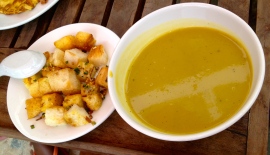 on january 1, 2013 i eat pumpkin soup, cambodian style, in honor of haiti’s independence day … and i am happily homesick.
on january 1, 2013 i eat pumpkin soup, cambodian style, in honor of haiti’s independence day … and i am happily homesick.
the last days of our holiday are spent in the capital city of phnom penh. we spend our time meandering the streets of this culturally rich city, resisting temptation to buy as we pass the amazing markets full of local art. We take a tuk-tuk to the russian market on the far end of town where i bargain for an amazing bag for less than $5 USD. there is a university for monks in the city center, consequently the streets are full of young monks dressed in their traditional orange robes. the combination of beautiful monks, the riverfront walkway and the plethora of parks and green spaces makes phnom penh a very beautiful city.
this holiday fed my soul. it was in need of much repair, as i was in need of time away from the desert, as well as time away from myself. i needed to reflect, to gain perspective, to remind myself of what it means to be a citizen of the world. and this trip did that for me … until the next one!
a few more pictures were required!
one of the best things about living in the empty quarter desert is its location. it really is like midtown of the globe. i can get just about anywhere relatively quickly and inexpensively – with the exception of the americas, of course. a goal of mine, while i’m in this hemisphere, is to travel and experience as much of this side of the planet as possible. i have an intense ‘travel bug’. i haven’t always had this bug. i mean, i’ve always wanted to travel, of course, but in just the past few years has the bug gotten serious. i think it began when i started visiting haiti and fell in love with a different culture and way of life. since then, i have jumped at the chance to go anywhere new. to see a new place, to take in the sights and smells and sounds of a new culture…
View original post 2,688 more words
soul food
one of the best things about living in the empty quarter desert is its location. it really is like midtown of the globe. i can get just about anywhere relatively quickly and inexpensively – with the exception of the americas, of course. a goal of mine, while i’m in this hemisphere, is to travel and experience as much of this side of the planet as possible. i have an intense ‘travel bug’. i haven’t always had this bug. i mean, i’ve always wanted to travel, of course, but in just the past few years has the bug gotten serious. i think it began when i started visiting haiti and fell in love with a different culture and way of life. since then, i have jumped at the chance to go anywhere new. to see a new place, to take in the sights and smells and sounds of a new culture. to meet the people and hear their stories and learn about their insights and perspectives on the world. to see the art and architecture of a place and to eat. i frequently eat my way through a new place … tempting my senses with the smells and textures and tastes of new foods. thankfully, i have somewhat of an iron stomach that tolerates my ‘adventurous’ eating.
we had three weeks off over christmas/new year’s holidays and i have been busy mending a broken heart, so some friends and i decided to take a big trip. we chose to go the spiritual route and visit vietnam and cambodia.
our trip beings when nancy & i hop on our upgraded emirates flight to hanoi, vietnam. we arrive late at night and are swooped into some gypsy taxi & that takes us to our hotel in the “old quarter”. this is a lovely area of the city – one of it’s original four districts – that has narrow, winding streets closely lined with tall, old, wooden buildings that look as if they may fall down onto the street at any minute. old quarter is charming and welcoming with a huge french influence in the architecture. there are markets everywhere and street vendors on every corner. we sleep for a few hours before a breakfast of pho ga (noodle soup with chicken) and strong, thick, delicious sludge-like coffee. at 7:30 am we are picked up by benh, our tour guide for the next week.
benh takes us on a trip north of hanoi where we see amazing grottos and pagodas and mountains and waterfalls. we stay in a tae village in the extreme north eastern corner of vietnam, on the china border. the village is very small and all of the residents are “minority people”, meaning they are people of particular vietnamese ethnic groups living traditionally, as their ancestors have for centuries.
the village is situated high up in the mountains on ba be lake (three lakes lake). the people depend on the lakes for much of their livelihood, as they are fishermen and farmers.here we stay with a local family in a “home-stay”.this home-stay is not like any other i have experienced. it is more like staying in someone’s spare room and using their spare bathroom. except, i guess, normally these homes would not have spare bedrooms or bathrooms. homes of the village are built up high on stilts (the lakes do flood, apparently) and they are very simple with bamboo floors, thatched roofs, and windows that are tied open and shut using a string.
our meals are prepared over an open fire in the kitchen and we eat on a mat that is spread on the floor of the main room just for meal time. the food is fresh and delicious… spring rolls, fish, morning lories, shrimp, bamboo, greens, pork, and, of course, rice and soup (broth). meals in this quaint village are served with corn wine (in lieu of rice wine – corn wine can be made faster and cheaper). corn wine is strong … it tastes like grain alcohol. however, one can not be rude, so i drink. nancy and i both become quite agile with our chop sticks, although benh tells us we are not proficient until we can catch a mosquito in mid-air. hump!
we visit several waterfalls, including the ban gioc waterfalls that separate northern vietnam from china. we also see about 100 grottos (caves). the caves are lovely – dark and cool, winding deep into the earth with stalactites and stalagmites everywhere. most caves have about 300 steps up the side of a mountain to the entrance, then another 300 deep under the surface of the earth, then of course one must come back up! nancy & i decide benh either must be trying to kill us from exhaustion or he’s on a secret geology mission of some sort.
benh takes us to several large street markets, where we try quite the variety of foods. my favorite was this donut-style rice ball of fried deliciousness! the street markets of vietnam are impressive. they are huge structures that take up entire city blocks. the markets themselves look as if they began with a plan, but over time the plan was abandoned in order to cram small vending stalls in every nook and cranny. the markets spill over on to the surrounding streets and the alleyways. every square inch of sidewalk, road, and wall are covered in goods to be sold. the vendors fill their stalls to the absolute brim – from floor to ceiling and in every possible pathway, making walking an obstacle course. weaving through the market stalls fills the senses. the sights – from vegetables, to raw meats of every variety, handbags, tourist mementoes, kitchen and housewares, auto parts and home-goods, noodles made on the spot, amazing arrays of fresh spices, clothes, jewelry….. with all of the colors and textures and intricate art works, the visual display is impressive. the smells are equally overwhelming – foods, spices, leather, flowers, vegetables, synthetic goods, human sweat, perfumes, raw meat, salt, plastics, auto supplies – all mingling to fill the air with an aroma that can’t be matched. the constant hum of feet on pavement, motorcycles and bikes, vendors calling out, flies & mosquitoes, people haggling over prices, leaves one drained before you have even begun to bargain for your own goods. luckily, very few of the vendors are “hard sells”, so one can enjoy the simple experience of prodding about and finding just the right treasure.
along the way, nancy and i are busy learning the customs and “do’s & don’t’s” of vietnam. for instance – one NEVER goes to a public restroom in vietnam without first rolling up their pants and one ALWAYS takes tissue and some sort of hand cleaner. one ALWAYS eats the food that is offered, for it will be forced upon you anyway. and one ALWAYS bargains for purchases with a smile. 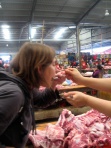
our week with benh ends and we return to hanoi where nancy and i spend an entire day wandering the streets … we visit street markets, get a massage, eat an amazing lunch, check out great tourist spots … a lovely day in the capital city.
that night, marie arrives in hanoi and the three of us head to the water puppet show. this is an ancient vietnamese tradition which involves intricate hand made wooden puppets. the puppeteers are behind the curtain standing in 3-feet deep water to maneuver the puppets for the show, which is a musical telling of ancient vietnamese folktales.
the next day we head to holong bay, north and east of hanoi. halong bay is famous for its rock islands filled with grottos. we take a boat cruise around the bay for the day. onboard we are served a lunch of fresh seafood and wine. we take a stop at one of the rock islands to see several grottos. yes, more caves. we see the floating fishing villages of halong bay and countless beautiful vistas.
the next day we go to the city of ninh binh to the visit bai dinh pagoda, the oldest pagoda in southeast asia. it is quite interesting – it’s actually two pagodas – the old and the new. the old is over 1000 years old, in a cave and very simply beautiful. the new is a man made structure and it is incredibly impressive and very informative, but it lacks the spiritual feeling of the old pagoda in the cave.
we eat an amazing lunch on the side of the road … morning lories, goat, rice, cabbage, and broth. of course, all meals in vietnam are accompanied by rice wine. which i quickly decide i love.
next we take a boat trip to visit the trang an grottoes. this is a gathering of over 30 valleys and more than 50 cross-water caves. it is a cold, rainy day … but beautiful none the less.
on one of our drives through the country side we stop by a cemetery. the cemeteries in vietnam are a sight to behold! the graves go in all directions and there appears to be no real plan to how the plots are laid out. we discover that within the cemetery you will see two different types of graves: the first grave and the final grave. vietnamese tradition says that when someone dies you first bury them in a simple box in a very shallow grave where they rest for three years. each month on the anniversary of their death, family members go to the site to make offerings in the name of their loved one. on the third anniversary of the death, the remains are dug up, the bones cleaned, and transferred into the bone casket. now the final grave is dug and the deceased goes to their final resting spot. here the fortune teller advises the family as to which direction to face the grave and what type of tomb to give the deceased. an interesting tradition that makes for very beautiful and unique cemeteries.
we return to hanoi in time to catch a plane that takes us south to hoi ann, in central vietnam. here we spend a lazy night and a lovely day wandering the streets of this ancient city. the city reminds me of savannah, in that it is both an old city built around a river, and that it is very tourist oriented. while it is quite old and very lovely, not much of it feels authentic. however, it does have amazing fabrics! hoi ann is known for fabrics and tailoring. if you need clothing made quickly of good quality, this is the place to go! i had two pair of pants custom sewn on the street for under $10 USD each in less than four hours. the streets of hoi an are narrow and winding, almost alley-like. the buildings are old and well-preserved. the french architecture is not as propionate in this little town … it almost looks like some english village with the thatched roofs, shuttered windows, and creeping ivy covered walls.
after wandering the streets all day, a late afternoon rain shower rolls in. we decide we will spend the rest of the afternoon at a little cafe on a sweet side street. here we drink amazing coffee, eat ice cream delights and smoke shisha. we quickly become friends with the ladies who work in the cafe. i have spent the last five days searching for a flag of the five elements. this is something i saw when we were in the north and i feel in love with it. in buddhism the five elements are: metal, wood, earth, water, and fire and each element is essential for a balanced world. i plead my case to one of the ladies working in the cafe and she says “i’ll be right back”. before i can protest, she is off on her bike. in 30 minutes or so she returns with a flag of the five elements for me! i am told that these are not meant for tourists and it would have been very difficult for me to purchase on my own. wow. i am amazed and so happy to have this beautiful flag!
the next morning we catch a flight to south vietnam, ho chi minh city (locals still refer it as saigon). we immediately catch a ride even further south to spend a few days in the beach town of voung tao. voung tao is an interesting town that is clearly not developed for western tourists, but rather for vietnamese beach-goers. we find our way to our hotel very late, only to discover no one in our hotel speaks english and we are in a room meant for a very loving couple. luckily, we are very expressive and persuasive women, and are able to get moved to a more suitable room. after such a late night, we leisurely head out to the beach for the morning. in the late afternoon we find our way to an impressive italian restaurant where we spend a long afternoon over wine, caprese, filled with lots of talking and laughing. later we walk along the sea-walk to find a hotel with a spa, where we all get massages and enjoy the sauna and steam room. massages in vietnam are interesting …. privacy as we know it as westerns is not a priority. the therapist, who stays in the room with you while you undress and waits for you to get on the table to cover you up, may make comments about your body. sometimes these comments are accompanied by pointing or grabbing to be sure the point is made.
after our massages, we make the long walk along the coast back to our hotel. it is christmas eve and the streets are packed with local party-goers. christmas is being celebrated in this little beach town as children are dressed in Santa suits and families are in all of the cafes and bars drinking and chatting, “snow” is blown onto the street from one of the pubs, and locals take their photographs with a variety of Santas. a lovely experience.
christmas morning we wake, drink a bottle of wine then catch the ferry back to saigon. our hotel in ho chi minh is right in the city center. we can walk everywhere – and we do! ho chih minh is hot and humid … my clothes and hair feel sticky, but my skin is so happy, soaking up the much needed moisture. we spend the day wandering the streets and getting a feel for the city. ho chi minh is very differnt from hanoi. althoug the streets of ho chi minh are small and easy to navigate, the city feels huge. the traffic is not as dense as hanoi and i am no where near as concerned for my safety crossing the streets (or have i become asscusdomed to these crazy, crowed streets?); however, the streets feel as if i could walk for days and days and never not run out of city to walk. we wander late into the night and end up in a very interesting “vip” style club. i believe we are the only women there who are not on the clock. there is a dance stage with very provocative dancers under a disco ball and hazy smoke which is sprayed every few minutes to keep up the mysterious atmosphere. the servers light cigarettes for the patrons, bring lined glasses for cell phones (because a cell phone can not sit directly on the table, of course), hurry over with hand wipes if you look as if you may munch on a nut, refill the ice in your glass using tongs and an ice bucket, and if you insist on drinking your beer from the bottle, they actually wrap the napkin around the bottle for you. we stayed late into the night, finally making our way back to our hotel in the wee hours of the morning. all of this is on foot in the heart of the city. not once did i feel unsafe or threatened.
ho chi minh has a lovely square at the city center, as well as “little notre dame” and an amazing old postoffice. it is also home to a massive western shopping district, complete with stores such as dolche & gabbana, louis vuitton, and tiffany’s.
one day while meandering the city streets, we happen upon a small, local arts festival. tall types of art is on display ~ floral art, paintings, sculptures, wood carvings, jewelry, photography … one beautiful piece after another. near the center of the park there is a monk set up with all of his paintings on display. he offers gifts to patrons for free. he paints your name with a personalized little picture for each name. naturally, we all must have our names painted. they each turn out uniquely beautiful.
what a lovely way to end our time in vietnam!
i will tell you about cambodia another day ….
humor is essential in the desert
a few months ago, some friends & i spent a weekend on the outskirts of dubai. so often i try to explain to my friends or family what it is like living in the uae, almost always unsuccessfully.
thinking back, i believe this weekend exemplifies life in the uae. nothing is as expected…
my friends and i booked a ‘chalet’ (like a cute little hut/house on the water) for 6 people through groupon for the weekend. the booking is to include a boat ride with fishing & swimming & snorkeling, as well as a private beach. at least, this is what we thought we booked…..
thursday after work, four of my friends and i head out. we drive the 2 hours to dubai and find the marina just outside of the city. when we get in, we go directly to the marina so we won’t miss our boat-ride that is booked for, well, now. naturally, the boat isn’t there “oh, i didn’t know you were coming” says cute mr. italian manager. “oh, i didn’t know what you were booking for” says flirty mr. lebanese manager …
this place is just on the edge of dubai and these two serious playboy party boys own it. they are hilarious – but business is not their strong suit! so, mr. cutie and mr. flirty, where is our boat? when will we leave the dock for our snorkeling, fishing, & swimming? sorry, miss, the boat is at the other marina 45 minutes away. excuse me?
ok, we’ll try to boat-ride later. please show us to our chalet. no problem, miss.
mr. cutie & mr. flirty drive us over the bridge to where the chalets are. there is a row of 7 newly constructed chalets along the waterfront. they are adorable little pentagonal wooden buildings with a small front porch and big windows. however, even from outside, we can see they are tiny. we are shown to our chalet, the first one in the row, and coincidentally, the one that looks the most near completion. ours is a chalet for TWO – there are FIVE of us … there is one bed, a sofa, and a love seat. there is no kitchen, no grill, no extra bedding, not even a trash can! the place isn’t even really finished being built … wow.
we call and ask that extra bedding be delivered so that we may all pile on the bed, sofas, and floor. we also ask for a grill and kitchen utensils, so that we may cook dinner later. inshallah, it will come.
we decide to go to our ‘private beach’ to enjoy the afternoon sun and some much deserved frolicking in the ocean. we call “captain lello” – captain lello is also italian, looks about 99 years old, and is wearing more gold than king tut. a gold MONKEY is around his neck!
captain lello takes us to our “private beach” in his little dingy boat …. ummmm…. yes, it’s private. it’s a small batch of sand on the edge of the marina canal and that’s it. this patch of sand looks like the remnants of the canal bottom that was widened for the marina. there is a little thatched & rusted tent type thing for shade, sand, and water. not a single chair, no table, not another soul on this patch of sand that you can only get to by boat. naturally, caption lello drops us and leaves us to our own devices.
we talk again to mr. flirty lebanese manager – he tells us to be ready at 2 – someone will pick us up from our chalet for our boat ride … yeah!
we call captain lello, who comes back & collects us from the ‘beach’ … we go to our chalet & get ready…. 2:15 … nothing … 2:30 … nothing …. tap tap tap go my fingers…. 2:40 i call mr. flirty lebanese manager. “oh, sorry, i couldn’t find anyone to come get you. you should just drive here. it’s easy. i give you directions.” no thanks, adam … it’s in downtown Dubai & i am 3 mojitos in.
ok … tomorrow will be better, yes? yes. tomorrow will be better. but – we have plans in the afternoon – so it must be in the morning. no problem, miss, i be there myself. of course.
inshallah, i say to myself!
it’s early in the afternoon and beautiful out, so we all head to the pool at the super posh hotel that is connected to the marina. we are NOT guests of the hotel … we are at the lowly marina resort…. so, technically, we’re sneaking in somewhere we are surely not supposed to be. but i figured we had it coming.
as we are talking our way in to the pool with the security guy, we find out that the hotel is partially closed for the weekend for a private party for the KING of Bahrain! whaaaat???? naturally, we are going in, this is a must see!
we never saw the king himself (that we know of) … but we sure did swim with his entourage …. it was …. amazing.
in this conservative, muslim country …. the kings people were playing LOUD dirty american rap and wearing the teeny-tiniest bathing suits i’ve seen … they were keeping the bartender at the swim up bar so busy he had to call for backup. by the late afternoon there were 3 bartenders working … we stayed until the sun went down.
that night we cooked on the grill that we had some of the marina workers deliver to us. we cut up veggies & chicken using plastic knives on our coffee table that we drug outside. naturally, the kitchen utensils we asked for never made it to us. i made about a million gin & tonics and we listened to lots of REALLY LOUD arabic music that joesf (the lebanese assistant manager whose chalet is next to ours) put on for us. he also brought us over several bottles of vodka & mixers.
this is ok.
we didn’t have enough space for all of us to sleep – so josef slept in another employee’s villa & gave us his chalet. HILARIOUS!!! i am certain i slept in the dirty sheets of a man i don’t know.
saturday morning … surely adam will show for the boat ride, right? not a chance. but he did call – 2 hours after he was supposed to pick us up!
we spent the morning at the pool again … and when i talked to adam i was able to secure us a free weekend in the “big chalet” – i went to check it out & it really is big enough for 5 people. i feel certain we’ll see this come to fruition, right?
the weekend was crazy. and hilarious. and so typically UAE. i was so thankful that the people i was with were super chill and easy and fun. it could have been miserable if i were with people who just couldn’t roll with it. there are a lot of those people here, but i try to keep my distance, as i believe humor is essential to life in the desert.
-
Recent Posts
Archives
Categories
Meta
-
Join 365 other subscribers
